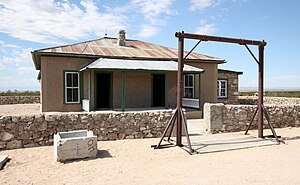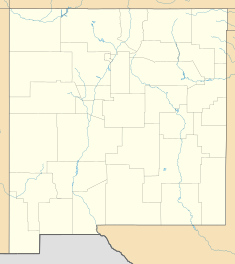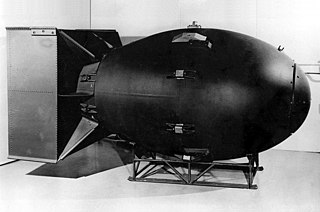
"Fat Man" was the codename for the type of nuclear weapon the United States detonated over the Japanese city of Nagasaki on 9 August 1945. It was the second of the only two nuclear weapons ever used in warfare, the first being Little Boy, and its detonation marked the third nuclear explosion in history. It was built by scientists and engineers at Los Alamos Laboratory using plutonium from the Hanford Site, and one was dropped from the Boeing B-29 Superfortress Bockscar piloted by Major Charles Sweeney.

The Manhattan Project was a research and development program undertaken during World War II to produce the first nuclear weapons. It was led by the United States in collaboration with the United Kingdom and Canada. From 1942 to 1946, the project was directed by Major General Leslie Groves of the U.S. Army Corps of Engineers. Nuclear physicist J. Robert Oppenheimer was the director of the Los Alamos Laboratory that designed the bombs. The Army program was designated the Manhattan District, as its first headquarters were in Manhattan; the name gradually superseded the official codename, Development of Substitute Materials, for the entire project. The project absorbed its earlier British counterpart, Tube Alloys. The Manhattan Project employed nearly 130,000 people at its peak and cost nearly US$2 billion, over 80 percent of which was for building and operating the plants that produced the fissile material. Research and production took place at more than 30 sites across the US, the UK, and Canada.

Los Alamos National Laboratory is one of the sixteen research and development laboratories of the United States Department of Energy (DOE), located a short distance northwest of Santa Fe, New Mexico, in the American southwest. Best known for its central role in helping develop the first atomic bomb, LANL is one of the world's largest and most advanced scientific institutions.

Trinity was the code name of the first detonation of a nuclear weapon, conducted by the United States Army at 5:29 a.m. MWT on July 16, 1945, as part of the Manhattan Project. The test was of an implosion-design plutonium bomb, nicknamed the "gadget", of the same design as the Fat Man bomb later detonated over Nagasaki, Japan, on August 9, 1945. Concerns about whether the complex Fat Man design would work led to a decision to conduct the first nuclear test. The code name "Trinity" was assigned by J. Robert Oppenheimer, the director of the Los Alamos Laboratory, inspired by the poetry of John Donne.

White Sands Missile Range (WSMR) is a United States Army military testing area and firing range located in the US state of New Mexico. The range was originally established in 1941 as the Alamogordo Bombing and Gunnery Range, where the Trinity test site lay at the northern end of the Range, in Socorro County near the towns of Carrizozo and San Antonio. It then became the White Sands Proving Ground on 9 July 1945.

Cyril Stanley Smith was a British metallurgist and historian of science. He is most famous for his work on the Manhattan Project where he was responsible for the production of fissionable metals. A graduate of the University of Birmingham and Massachusetts Institute of Technology (MIT), Smith worked for many years as a research metallurgist at the American Brass Company. During World War II he worked in the Chemical-Metallurgical Division of the Los Alamos Laboratory, where he purified, cast and shaped uranium-235 and plutonium, a metal hitherto available only in microgram amounts, and whose properties were largely unknown. After the war he served on the Atomic Energy Commission's influential General Advisory Committee, and the President's Science Advisory Committee.

William Sterling Parsons was an American naval officer who worked as an ordnance expert on the Manhattan Project during World War II. He is best known for being the weaponeer on the Enola Gay, the aircraft which dropped an atomic bomb on Hiroshima, Japan, in 1945. To avoid the possibility of a nuclear explosion if the aircraft crashed and burned on takeoff, he decided to arm the bomb in flight. While the aircraft was en route to Hiroshima, Parsons climbed into the cramped and dark bomb bay, and inserted the powder charge and detonator. He was awarded the Silver Star for his part in the mission.

Seth Henry Neddermeyer was an American physicist who co-discovered the muon, and later championed the implosion-type nuclear weapon while working on the Manhattan Project at the Los Alamos Laboratory during World War II.
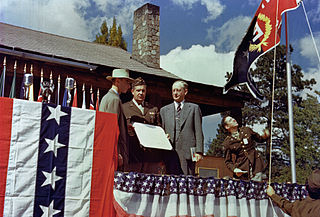
The Manhattan Project was a research and development project that produced the first atomic bombs during World War II. It was led by the United States with the support of the United Kingdom and Canada. From 1942 to 1946, the project was under the direction of Major General Leslie Groves of the US Army Corps of Engineers. The Army component of the project was designated the Manhattan District; "Manhattan" gradually became the codename for the entire project. Along the way, the project absorbed its earlier British counterpart, Tube Alloys. The Manhattan Project began modestly in 1939, but grew to employ more than 130,000 people and cost nearly US$2 billion. Over 90% of the cost was for building factories and producing the fissionable materials, with less than 10% for development and production of the weapons.

"Thin Man" was the code name for a proposed plutonium-fueled gun-type nuclear bomb that the United States was developing during the Manhattan Project. Its development was abandoned in 1944 after it was discovered that the spontaneous fission rate of nuclear reactor-bred plutonium was too high for use in a gun-type design due to the high concentration of the isotope plutonium-240.

Joseph William Kennedy was an American chemist who co-discovered plutonium, along with Glenn T. Seaborg, Edwin McMillan, and Arthur Wahl. During World War II, he led the CM Division at the Manhattan Project's Los Alamos Laboratory, where he oversaw research onto the chemistry and metallurgy of uranium and plutonium. After the war, he was recruited as a professor at Washington University in St. Louis, where he is credited with transforming a university primarily concerned with undergraduate teaching into one that also boasts strong graduate and research programs. He died of cancer of the stomach at the age of 40.

Silverplate was the code reference for the United States Army Air Forces' participation in the Manhattan Project during World War II. Originally the name for the aircraft modification project which enabled a B-29 Superfortress bomber to drop an atomic weapon, "Silverplate" eventually came to identify the training and operational aspects of the program as well. The original directive for the project had as its subject line "Silver Plated Project" but continued usage of the term shortened it to "Silverplate".

Atomic tourism or nuclear tourism is a form of tourism in which visitors witness nuclear tests or learn about the Atomic Age by traveling to significant sites in atomic history such as nuclear test reactors, museums with nuclear weapon artifacts, delivery vehicles, sites where atomic weapons were detonated, and nuclear power plants.

The Dayton Project was a research and development project to produce polonium during World War II, as part of the larger Manhattan Project to build the first atomic bombs. Work took place at several sites in and around Dayton, Ohio. Those working on the project were ultimately responsible for creating the polonium-based modulated neutron initiators that were used to begin the chain reactions in the atomic bombs.
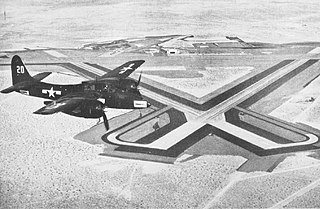
Project Camel encompassed the work performed by the California Institute of Technology (Caltech) in support of the Manhattan Project during World War II. These activities included the development of detonators and other equipment, testing of bomb shapes dropped from Boeing B-29 Superfortress bombers, and the Salt Wells Pilot Plant, where explosive components of nuclear weapons were manufactured.

Raemer Edgar Schreiber was an American physicist from McMinnville, Oregon who served Los Alamos National Laboratory during World War II, participating in the development of the atomic bomb. He saw the first one detonated in the Trinity nuclear test in July 1945, and prepared the Fat Man bomb that was used in the bombing of Nagasaki. After the war, he served at Los Alamos as a group leader, and was involved in the design of the hydrogen bomb. In 1955, he became the head of its Nuclear Rocket Propulsion (N) Division, which developed the first nuclear-powered rockets. He served as deputy director of the laboratory from 1972 until his retirement in 1974.

Marshall Glecker Holloway was an American physicist who worked at the Los Alamos Laboratory during and after World War II. He was its representative, and the deputy scientific director, at the Operation Crossroads nuclear tests at Bikini Atoll in the Pacific in July 1946. Holloway became the head of the Laboratory's W Division, responsible for new weapons development. In September 1952 he was charged with designing, building and testing a thermonuclear weapon, popularly known as a hydrogen bomb. This culminated in the Ivy Mike test in November of that year.
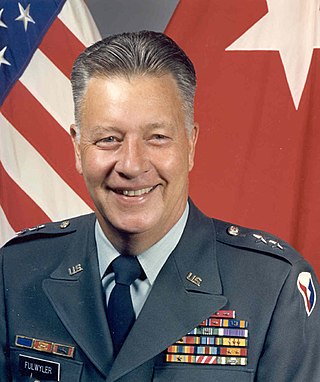
Niles J. Fulwyler was a United States Army major general who served as Commanding General of the White Sands Missile Range from 1982 to 1986.

The Los Alamos Laboratory, also known as Project Y, was a secret laboratory established by the Manhattan Project and operated by the University of California during World War II. Its mission was to design and build the first atomic bombs. Robert Oppenheimer was its first director, serving from 1943 to December 1945, when he was succeeded by Norris Bradbury. In order to enable scientists to freely discuss their work while preserving security, the laboratory was located on the isolated Pajarito Plateau in Northern New Mexico. The wartime laboratory occupied buildings that had once been part of the Los Alamos Ranch School.

Donald Francis Mastick was an American chemist who worked at the Manhattan Project's Los Alamos Laboratory. As part of Project Alberta, he was part of the planning and preparation for the atomic bombing of Hiroshima and Nagasaki, for which he was awarded the Bronze Star Medal. Mastick is known for a lab incident in 1944 when he accidentally ingested a small amount of plutonium, traces of which remained detectable in his body decades later. After the incident, he worked for the Naval Radiological Defense Laboratory and the Atomic Energy Commission.
